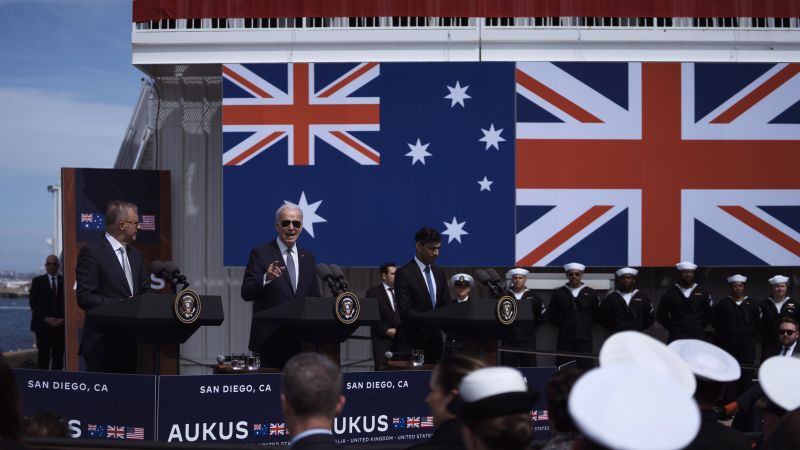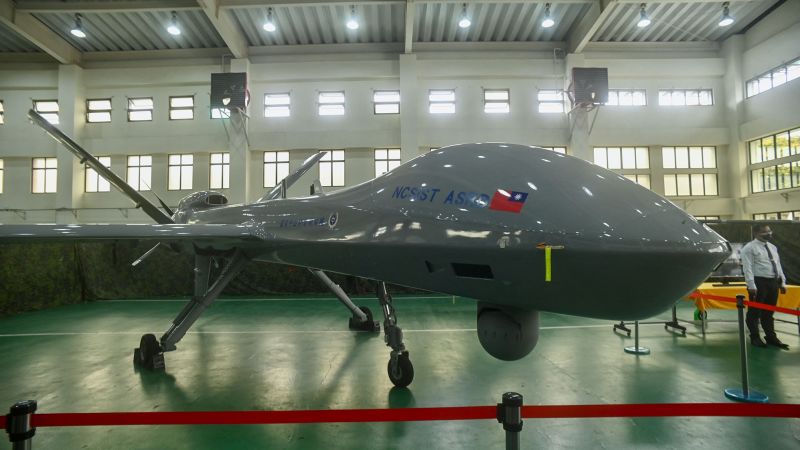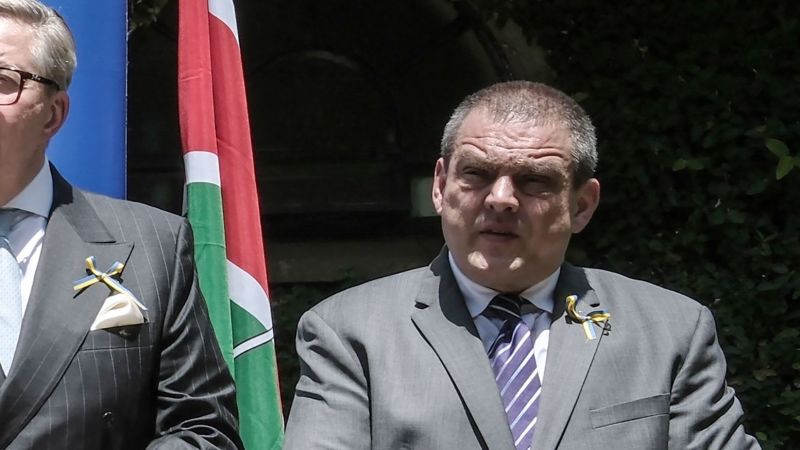Australia, the UK and US are joining forces in the Pacific, but will nuclear subs arrive quick enough to counter China?

Canberra, Australia
CNN
—
More than a year after the United States, the United Kingdom and Australia dropped the tightly held news they were combining submarine forces, the trio released more details Monday of their ambitious plan to counter China’s rapid military expansion.
Under the multi-decade AUKUS deal, the partners will build a combined fleet of elite nuclear-powered submarines using technology, labor and funding from all three countries, creating a more formidable force in the Indo-Pacific than any of them could achieve alone.
But the long timeline and huge financial costs – running into the hundreds of billions for Australia alone – pose questions about how far the partners’ plans could stray from their “optimal pathway” in the decades to come as governments, and potentially priorities, change.
In a joint statement Monday, US President Joe Biden, Australian Prime Minister Anthony Albanese and UK counterpart Rishi Sunak said the “historic” deal will build on past efforts by all three countries to “sustain peace, stability, and prosperity around the world.”
The plan begins this year with training rotations for Australian personnel on US and UK subs and bases in the expectation that in roughly 20 years, they’ll commandeer Australia’s first ever nuclear-powered fleet.
But there’s a long way to go between now and then, as outlined in a series of phases announced by the leaders as they stood side-by-side in San Diego Harbor.
From 2023, along with training Australians, US nuclear-powered subs will increase port visits to Australia, joined three years later by more visits from British-owned nuclear-powered subs.
Come 2027, the US and UK subs will start rotations at HMAS Stirling, an Australian military port near Perth, Western Australia that’s set to receive a multibillion dollar upgrade.
Then from the early 2030s, pending Congress approval, Australia will buy three Virginia-class submarines from the US, with an option to buy two more.
Within the same decade, the UK plans to build its first AUKUS nuclear-powered submarine – combining its Astute-class submarine with US combat systems and weapons.
Soon after, in the early 2040s, Australia will deliver the first of its homemade AUKUS subs to its Royal Navy.
As a series of bullet points on the page, the plan seems straightforward.
But the complexities involved are staggering and require an unprecedented level of investment and information sharing between the three partners, whose leaders’ political careers are set to be far shorter than those of the man they are working to counter: China’s Xi Jinping.
Last week China’s political elite endorsed Xi’s unprecedented third term, solidifying his control and making him the longest-serving head of state of Communist China since its founding in 1949.
The most assertive Chinese leader in a generation, Xi has expanded his country’s military forces and sought to extend Beijing’s influence far across the Indo-Pacific, rattling Western powers.
Richard Dunley, from the University of New South Wales, said Australia was under pressure to respond after years of inaction and the proposal is an impressive scramble for a workable plan.
“It’s a last roll of the dice. And they’ve managed to just about thread the eye of a needle coming up with something that looks plausible.”
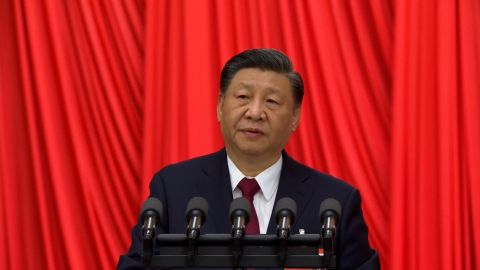
A rush of diplomacy took place before Monday’s announcement, partly to avoid the shock impact of the initial announcement in 2021, when French President Emmanuel Macron accused former Australian Prime Minister Scott Morrison of lying to him when he pulled out of a 90 billion Australian dollar deal to buy French subs.
That deal would have delivered new submarines on a faster timeline, but they would have been conventional diesel-powered vessels instead of state of the art nuclear ones.
Australia learned from that diplomatic row and its senior leaders – including Albanese – made around 60 calls to allies and regional neighbors to inform them of the plan before it was announced, according to Australian Defense Minister Richard Marles.
China wasn’t one of them.
Biden told reporters Monday that he plans to speak with Xi soon but declined to say when that would be, adding that he was not concerned Xi would see the AUKUS announcement as aggression.
That contrasts with the sentiment emerging from Beijing including its accusations the trio is fomenting an arms race in Asia.
At a daily briefing Monday, China’s Foreign Ministry spokesman Wang Wenbin said the AUKUS partners had “completely ignored the concerns of the international community and gone further down a wrong and dangerous road.”
He said the deal would “stimulate an arms race, undermine the international nuclear non-proliferation system and damage regional peace and stability.”
Peter Dean, director of Foreign Policy and Defense at the United States Studies Centre at the University of Sydney, said the Chinese claims are overblown.
“If there is an arms race in the Indo-Pacific, there is only one country that is racing, and that is China,” he told CNN.
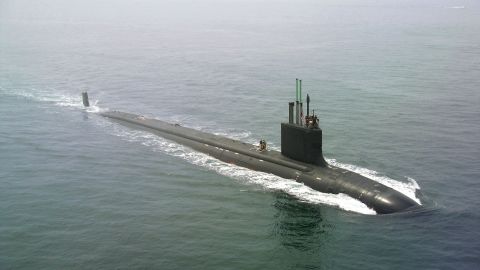
Smaller countries around the region are watching the AUKUS plan with concern that a greater presence in their waters could lead to unintended conflict, said Ristian Atriandi Supriyanto, from the Strategic & Defence Studies Centre at the Australian National University.
“With more rotational presence of US and UK subs in Australia, there is a greater necessity for China to surveil these units and thereby, increase the likelihood of accidents or incidents at sea,” he said.
Biden stressed Monday that he wanted “the world to understand” that the agreement was “talking about nuclear power not nuclear weapons.”
According to a White House fact sheet, the US and UK will give Australian nuclear material in sealed “welded power units” that will not require refueling. Australia has committed to disposing of nuclear waste in Australia on defense-owned land. But that won’t happen until at least the late 2050s, when the Virginia-class vessels are retired.
Australia says it doesn’t have the capability to enrich it to weapons grade, won’t acquire it and wants to abide by International Atomic Energy Agency (IAEA) principles on non-proliferation.
The AUKUS plan is an admission by Australia that without submarines that can spend long periods of time at great depths, the country is woefully unprepared to counter China in the Indo-Pacific.
“It is hugely complex and hugely risky,” said Dunley from the University of New South Wales.
“But when the original announcement and decision was made in 2021, there were very few good options left for Australia. So I think they’ve come out as well as they could have done,” he added.
Challenges are posed by a project of this scale, which includes many moving parts with potential knock-on effects to the timeline and cost.
The deal involves upgrades to ports and fleets, including expanding the operational life of Australia’s Collins-class submarines to the 2040s, to aid in the transition to nuclear.
“You’re having to take submarines out for quite a significant chunk of time to refit them, and if there are delays or issues that could cascade, you could see issues where Australia actually doesn’t have enough submariners to maintain its current forces of mariners, let alone augment that,” Dunley said.
As all three countries race to expand their fleets, training enough staff could become a serious challenge, Dunley said.
The security element of the roles mean the pool of skilled workers is inevitably shallow. Efforts are being made in all countries to entice trainees to a life below the surface of the sea for months at a time – potentially not an easy sell in a competitive jobs market.
And then there’s the funding.
The Australian government says it’ll find 0.15% of gross domestic product every year for 30 years – a cost of up to $245 billion (368 billion Australian dollars).
Max Bergmann, the director of the Europe Program at the Center for Strategic and International Studies, said the deal will ultimately require healthy economies, and all three countries are dealing with cost of living pressures.
“The UK economy is not doing great. And part of what it will need is a thriving economy, such that it can maintain the level of spending needed,” he told a reporter briefing.
Xi’s move to allow himself to retain the Chinese leadership for life means he could be approaching his 90s by the time Australia and Britain have launched their new AUKUS fleets.
By then, the landscape of the Indo-Pacific could be vastly changed.
Xi, 69, has made it clear that the issue of Taiwan, an island democracy that China’s Communist Party claims but has never ruled, cannot be passed indefinitely down to other generations.
For now, Australia says it is confident of continued bipartisan support in Washington for the program, which will rely on the ongoing transfer of nuclear material and other weapons secrets from the US.
“We enter this with a high degree of confidence,” Defense Minister Marles said Monday.
However the risk remains that in future years an inward-facing US leader in the style of former President Donald Trump – or even perhaps Trump himself – could emerge to threaten the deal.
Charles Edel, senior adviser at the Center for Strategic and International Studies, said the deal was about much more than a combined effort to change China’s calculations about its security environment.
“It’s meant to transform the industrial shipbuilding capacity of all three nations, it’s meant as a technological accelerator, it’s meant to change the balance of power in the Indo-Pacific, and, ultimately, it’s meant to change the model of how the United States works with and empowers its closest allies.”


